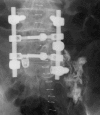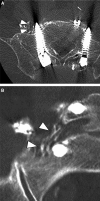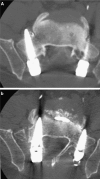L5 spinal nerve injury caused by misplacement of outwardly-inserted S1 pedicle screws
- PMID: 23269529
- PMCID: PMC3641263
- DOI: 10.1007/s00586-012-2634-z
L5 spinal nerve injury caused by misplacement of outwardly-inserted S1 pedicle screws
Abstract
Purpose: To evaluate L5 nerve root injuries caused by outwardly misplaced S1 pedicle screws. Pedicle screws remain the criterion standard for fixation of L5-S1 to correct lumbosacral instability. When inserting S1 pedicle screws, it is possible to injure the L5 nerve root if screws are inserted outwardly and the tip of the screw perforates the anterior cortex of the sacrum. Despite this risk, to our knowledge this type of injury has never been reported as a case series.
Methods: We experienced 2 cases of L5 nerve root injury caused by outwardly-inserted S1 pedicle screws. In both cases, bilateral S1 pedicle screws were inserted outwardly using a free-hand technique, and on one side, screws induced severe pain by impinging on an L5 root. Computed tomography after the selective rootgraphy of the injured nerve showed the nerve compressed laterally by screw threads in Case 1 and crushed between the screw threads and the sacral body in Case 2.
Results: In both cases, leg pain disappeared immediately after the infiltration of the nerve with lidocaine, but symptoms recurred within a few days in Case 1 and within an hour in Case 2. Conservative treatment of three spinal nerve infiltrations was effective in Case 1, but reinsertion of the rogue screw was necessary in Case 2.
Conclusions: Surgeons should recognize that lateral inclination of S1 pedicle screws can cause L5 nerve root injury, which may require reinsertion of the screw, especially in cases where insertion is difficult because of overlapping surrounding muscle or bony tissue.
Figures




Similar articles
-
L5 nerve root injury caused by anterolateral malpositioning of loosened S1 pedicle screws: illustrative cases.J Neurosurg Case Lessons. 2021 Jun 21;1(25):CASE21207. doi: 10.3171/CASE21207. eCollection 2021 Jun 21. J Neurosurg Case Lessons. 2021. PMID: 35855081 Free PMC article.
-
Determination of a neurologic safe zone for bicortical S1 pedicle screw placement.Spine J. 2022 Oct;22(10):1708-1715. doi: 10.1016/j.spinee.2022.04.016. Epub 2022 Apr 30. Spine J. 2022. PMID: 35504567
-
Misplaced S1 screw causing L5 radiculopathy, rare and unusual presentation: a report of 2 cases.Br J Neurosurg. 2024 Feb;38(1):131-135. doi: 10.1080/02688697.2021.1967286. Epub 2021 Aug 16. Br J Neurosurg. 2024. PMID: 34396884
-
Proposed alternative revision strategy for broken S1 pedicle screw: radiological study, review of the literature, and case reports.Spine J. 2013 Jul;13(7):796-802. doi: 10.1016/j.spinee.2013.03.018. Epub 2013 Apr 19. Spine J. 2013. PMID: 23608561 Review.
-
Current trends in pedicle screw stimulation techniques: lumbosacral, thoracic, and cervical levels.Neurodiagn J. 2012 Jun;52(2):100-75. Neurodiagn J. 2012. PMID: 22808751 Review.
Cited by
-
A study of sacral anthropometry to determine S1 screw placement for spinal lumbosacral fixation in the Korean population.Eur Spine J. 2015 Nov;24(11):2525-9. doi: 10.1007/s00586-015-4159-8. Epub 2015 Jul 31. Eur Spine J. 2015. PMID: 26228185
-
Pedicle Morphology of Lower Thoracic and Lumbar Spine in Ankylosing Spondylitis Patients with Thoracolumbar Kyphosis: A Comparison with Fracture Patients.Orthop Surg. 2022 Sep;14(9):2188-2194. doi: 10.1111/os.13429. Epub 2022 Aug 16. Orthop Surg. 2022. PMID: 35971839 Free PMC article.
-
Iatrogenic L5 Nerve Injury Following Decortication of the Sacral Ala in Posterolateral Lumbosacral Fusion Surgery.Global Spine J. 2022 Jun;12(5):890-893. doi: 10.1177/2192568220968773. Epub 2020 Nov 18. Global Spine J. 2022. PMID: 33203238 Free PMC article.
-
Anterolateral S1 screw malposition detected with intraoperative neurophysiological monitoring during posterior lumbosacral fusion.Surg Neurol Int. 2020 Mar 6;11:42. doi: 10.25259/SNI_4_2020. eCollection 2020. Surg Neurol Int. 2020. PMID: 32257568 Free PMC article.
-
More nerve root injuries occur with minimally invasive lumbar surgery, especially extreme lateral interbody fusion: A review.Surg Neurol Int. 2016 Jan 25;7(Suppl 3):S83-95. doi: 10.4103/2152-7806.174895. eCollection 2016. Surg Neurol Int. 2016. PMID: 26904372 Free PMC article.
References
-
- Ledonio CG, Polly DW, Jr, Vitale MG, Wang Q, Richards BS. Pediatric pedicle screws: comparative effectiveness and safety: a systematic literature review from the Scoliosis Research Society and the Pediatric Orthopaedic Society of North America task force. J Bone Joint Surg Am. 2011;93:1227–1234. doi: 10.2106/JBJS.J.00678. - DOI - PubMed
Publication types
MeSH terms
LinkOut - more resources
Full Text Sources

